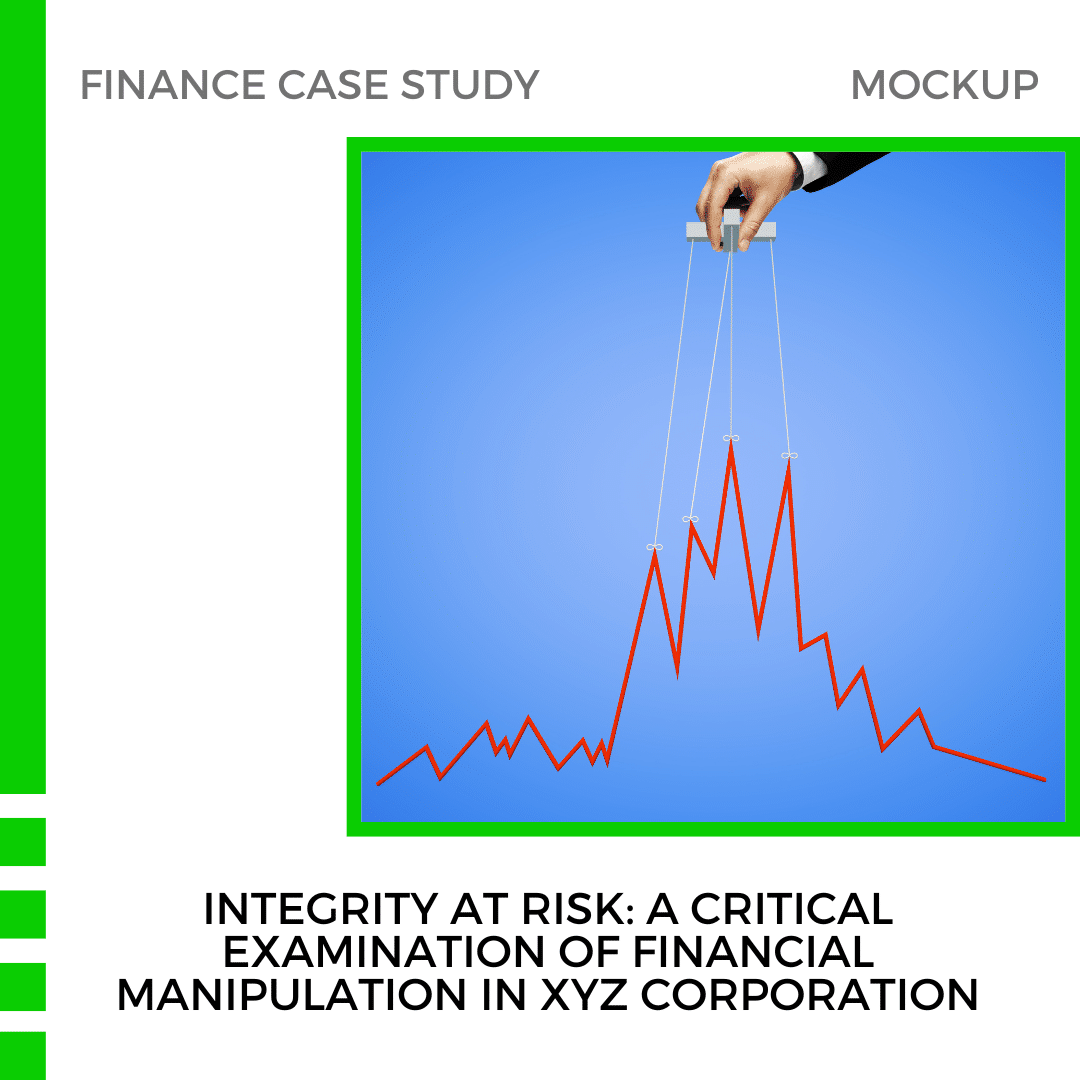
Integrity at Risk: A Critical Examination of Financial Manipulation in XYZ Corporation
Introduction
This case study examines the unethical practice of financial manipulation within XYZ Corporation, a fictional manufacturing company. We will explore the methods utilized to manipulate the profit and loss account, the motivations behind these actions, and the implications for various stakeholders. The analysis will focus on the provided dummy financial statements, highlighting signs of manipulation and proposing measures to prevent such unethical practices in the future.
Background of XYZ Corporation
Overview of XYZ Corporation
XYZ Corporation is a mid-sized company specializing in consumer electronics production. Established over a decade ago, it has gained a presence in the stock market and operates in a highly competitive environment. Recently, the company has experienced fluctuating financial performance, raising concerns among investors and stakeholders about the reliability of its reported results.
Recent Financial Performance
Despite operating in a challenging market, XYZ Corporation reported substantial profits for the latest financial year. However, internal whistleblowers have expressed concerns regarding the accuracy of the financial statements, suggesting possible manipulation that could mislead investors and regulatory authorities.
Methods of Financial Manipulation
Revenue Recognition
XYZ Corporation has been accused of prematurely recognizing revenue to inflate its reported income. This practice entails recording sales transactions before the actual delivery of products or services, thereby violating established accounting principles and ethical standards. Such actions can significantly distort the financial picture presented to stakeholders.
Expense Manipulation
The company has also been suspected of delaying expense recognition. By postponing the acknowledgement of costs incurred during the current reporting period, XYZ Corporation artificially inflates its profits, misleading stakeholders about its financial health and operational efficiency.
Off-Balance-Sheet Transactions
Moreover, XYZ Corporation allegedly engaged in off-balance-sheet transactions to obscure liabilities and enhance its financial ratios. This tactic involves using special purpose entities (SPEs) to keep certain assets and liabilities off the main balance sheet, creating a misleadingly favorable financial position for the company.
Dummy Financial Statements
Income Statement for the Year Ended December 31, 2023
| Item | 2023 (Reported) | 2023 (Actual) |
|---|---|---|
| Revenue | $500,000 | $450,000 |
| Cost of Goods Sold | $200,000 | $200,000 |
| Gross Profit | $300,000 | $250,000 |
| Operating Expenses | $100,000 | $150,000 |
| Operating Income | $200,000 | $100,000 |
| Interest Expense | $20,000 | $20,000 |
| Income Before Tax | $180,000 | $80,000 |
| Tax Expense | $54,000 | $24,000 |
| Net Income | $126,000 | $56,000 |
Balance Sheet as of December 31, 2023
| Assets | 2023 (Reported) | 2023 (Actual) |
|---|---|---|
| Cash and Cash Equivalents | $100,000 | $100,000 |
| Accounts Receivable | $80,000 | $50,000 |
| Inventory | $120,000 | $120,000 |
| Property, Plant, and Equipment | $300,000 | $300,000 |
| Total Assets | $600,000 | $570,000 |
| Liabilities and Equity | 2023 (Reported) | 2023 (Actual) |
|---|---|---|
| Accounts Payable | $50,000 | $50,000 |
| Accrued Expenses | $20,000 | $50,000 |
| Long-Term Debt | $150,000 | $150,000 |
| Total Liabilities | $220,000 | $250,000 |
| Shareholders’ Equity | $380,000 | $320,000 |
| Total Liabilities and Equity | $600,000 | $570,000 |
Analysis of Financial Manipulation
Revenue Recognition
The income statement indicates that revenue is inflated by $50,000 in the reported figures. This premature recognition of revenue suggests that XYZ Corporation recorded sales transactions before delivery, a clear violation of generally accepted accounting principles (GAAP).
Expense Manipulation
The operating expenses are understated by $50,000, misleadingly presenting an artificially high operating income. Delaying the recognition of these expenses not only misrepresents the company’s financial performance but also jeopardizes stakeholder trust and the integrity of financial reporting.
Off-Balance-Sheet Transactions
The balance sheet reflects an understatement of accrued expenses by $30,000, suggesting that certain liabilities may have been shifted off the balance sheet. This manipulation creates an illusion of a healthier financial position, potentially misleading investors and creditors regarding the company’s true obligations.
Tasks for Students
Task 1: Identify Signs of Manipulation
Analyze the dummy financial statements provided and identify specific signs of financial manipulation. Focus on discrepancies between the reported and actual figures for revenue, expenses, and liabilities.
Task 2: Evaluate the Impact
Evaluate the impact of financial manipulation on various stakeholders, including investors, employees, creditors, and regulatory authorities. Consider both the short-term and long-term consequences of such unethical practices.
Task 3: Propose Corrective Measures
Propose corrective measures to address financial manipulation within XYZ Corporation. Suggest strategies such as strengthening internal controls, enhancing transparency, and implementing stricter regulatory oversight.
Task 4: Develop an Ethical Framework
Develop an ethical framework for financial reporting that XYZ Corporation can adopt to ensure accuracy and integrity in its financial statements. Consider principles such as honesty, accountability, and transparency.
Possible Solutions to Address Financial Manipulation at XYZ Corporation
Addressing financial manipulation requires strong controls, governance, ethical practices, and transparency. Below are practical solutions to prevent and mitigate such issues.
1. Strengthening Internal Controls
- Segregation of Duties: Separate reporting, approval, and audit tasks to prevent fraud.
- Regular Audits: Conduct internal and external audits to ensure compliance.
- Whistleblower Protection: Enable safe reporting of unethical practices.
2. Improving Governance and Oversight
- Audit Committee: Independent oversight of financial reporting.
- Executive Accountability: Tie incentives to sustainable performance.
- Regulatory Compliance: Follow GAAP or IFRS to maintain transparency.
3. Ethical Financial Reporting Framework
- Code of Ethics: Enforce standards of integrity.
- Training: Regular sessions on ethics and fraud prevention.
- Leadership Commitment: Set an ethical example from the top.
4. Realigning Incentives
- Balanced KPIs: Focus on both short- and long-term goals.
- Deferred Compensation: Reward sustainable performance over time.
- Profit-sharing: Align employee interests with company health.
5. Leveraging Technology
- ERP Systems: Ensure accurate transaction tracking.
- Real-Time Monitoring: Use analytics to detect anomalies.
- Blockchain: Maintain tamper-proof financial records.
6. Collaborating with Regulators
- Disclosures: Provide timely reports to authorities and investors.
- Third-Party Audits: Validate compliance with regulations.
- Industry Engagement: Participate in transparency initiatives.
7. Crisis Management and Communication
- Public Disclosure: Address issues promptly to rebuild trust.
- Engagement: Keep stakeholders informed of corrective actions.
- Restorative Measures: Restate financials and penalize wrongdoers.
By combining internal controls, ethical practices, and technology, XYZ Corporation can prevent financial manipulation. Aligning incentives, fostering transparency, and collaborating with regulators will ensure sustainable growth and restore trust in the company.
Conclusion
The case of financial manipulation within XYZ Corporation highlights the critical importance of ethical financial reporting and the potential consequences of misleading stakeholders. Students can identify signs of manipulation by analyzing the dummy financial statements and propose corrective measures to prevent such practices. This case study fosters a deeper understanding of the ethical and practical challenges associated with financial reporting, emphasizing the need for rigorous standards and accountability in the corporate sector.
References
- International Financial Reporting Standards (IFRS). (n.d.). Retrieved from IFRS
- Financial Accounting Standards Board (FASB). (n.d.). Retrieved from FASB
- Accounting Ethics: A Critical Approach. (2020). Journal of Business Ethics. Retrieved from Springer
- U.S. Securities and Exchange Commission (SEC). (n.d.). Financial Reporting Manual. Retrieved from SEC
These sources provide valuable insights into accounting principles, ethical standards, and the implications of financial manipulation in corporate finance.
Explore Business Models of Global Companies and Indian Companies



